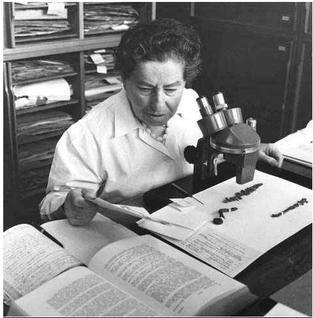
Eden Phillpotts was an English author, poet and dramatist. He was born in Mount Abu, India, was educated in Plymouth, Devon, and worked as an insurance officer for ten years before studying for the stage and eventually becoming a writer.
AFI's 100 Years...100 Stars is the American Film Institute's list ranking the top 25 male and 25 female greatest screen legends of American film history and is the second list of the AFI 100 Years... series.

Clara Kimball Young was an American film actress who was popular in the early silent film era.

The Rev. William Keble Martin was a Church of England priest, botanist and botanical illustrator, known for his Concise British Flora in Colour.

Sir Albert Charles Seward FRS was a British botanist and geologist.
Lilian Suzette Gibbs (1870–1925) was a British botanist who worked for the British Museum in London and an authority on mountain ecosystems.

Frederick Orpen Bower FRSE FRS was an English botanist. He was elected a Fellow of the Royal Society in 1891. He was awarded the Gold Medal of the Linnean Society in 1909 and the Darwin Medal of the Royal Society in 1938. He was president of the British Association in 1929–1930.

Per Axel Rydberg was a Swedish-born, American botanist who was the first curator of the New York Botanical Garden Herbarium.
Leonard Rodway was an English-born Australian dentist and botanist.

Ethelbert Blatter SJ was a Swiss Jesuit priest and pioneering botanist in British India. Author of five books and over sixty papers on the flora of the Indian subcontinent, he was Principal and Professor of Botany at St Xavier College, Bombay and Vice-President of the Bombay Natural History Society. In 1932, he became the first recipient of the Johannes Bruehl Memorial Medal of the Asiatic Society of Bengal.

Dame Helen Charlotte Isabella Gwynne-Vaughan, was a prominent English botanist and mycologist. During the First World War, she served in the Women's Army Auxiliary Corps and then as Commandant of the Women's Royal Air Force (WRAF) from 1918 to 1919. During the Second World War, from 1939 to 1941, she served as Chief Controller of the Auxiliary Territorial Service (ATS).

Sir Arthur William Hill was Director of the Royal Botanic Gardens, Kew, and a noted botanist and taxonomist.

Harry Temple Morey was an American stage and motion picture actor who appeared in nearly 200 films during his career.

Lucy May Cranwell was a New Zealand botanist responsible for groundbreaking work in palynology. Cranwell was appointed curator of botany at Auckland Museum in 1929, when she was 21 years old. As well as her work on ancient pollen samples she was responsible for encouraging a love of botany in a generation of Auckland children.

Harry Howard Barton Allan was a New Zealand teacher, botanist, scientific administrator, and writer. Despite never receiving a formal education in botany, he became an eminent scientist, publishing over 100 scientific papers, three introductory handbooks on New Zealand plants, and completing the first volume of a flora in his lifetime.

Charles Edward Moss, was an English-born South African botanist, the youngest son of a nonconformist minister, and is noted for being the editor of the first two parts of The Cambridge British Flora published in 1914 and 1920. The Cambridge British Flora, under the editorship of Moss, was intended to be a ten-volume survey of the flora of Britain, with contributions by specialists in particular genera. The two volumes that saw publication were of a very high standard, but the project was subsequently abandoned.

Kathleen Bever Blackburn, (1892–1968) was a British botanist best remembered for the 1923 discovery that plant cells have sex chromosomes. Her principal contributions were in plant cytology and genetics. She was also a pioneer of pollen analysis. She taught botany at Armstrong College, Durham University from 1918 to 1957.

Naomi Feinbrun-Dothan was a Russian-born Israeli botanist, who became part of the academic staff at the Hebrew University of Jerusalem. She studied the flora of Israel and published dozens of articles and several analytical flora books. Just after her 91st birthday, she received the 1991 Israel Prize for her unique contribution to the Land of Israel studies.
Frank Lincoln Stevens was an American mycologist and phytopathologist. He gained an international reputation as one of the preeminent mycologists.















